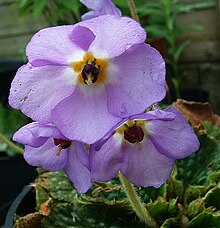Serbian rock plate
| Serbian rock plate | ||||||||||||
|---|---|---|---|---|---|---|---|---|---|---|---|---|

Serbian rock plate ( Ramonda serbica ), illustration |
||||||||||||
| Systematics | ||||||||||||
|
||||||||||||
| Scientific name | ||||||||||||
| Ramonda serbica | ||||||||||||
| Pančić |
The Serbian rock plate ( Ramonda serbica ) is a type of plant from the Gesneriae family (Gesneriaceae). Together with the other two Ramonda species, the species is one of the only European poiclohydric higher plants .
description
The Serbian rock plate is an evergreen, perennial , herbaceous plant that reaches heights of 5 to 15 centimeters. The species is very similar to Ramonda nathaliae . The narrow, obovate rosette leaves are 4 to 7 cm long and 2 to 3.5 cm wide. The base of the leaf blade is wedge-shaped and ends in an indistinct, short, wide petiole. The leaf margin has an irregular and sometimes deep notch or serration.
Several stems with one to three upright to nodding flowers often grow out of the leaf rosette. The shafts, pedicels and calyx are hairy glandular and downy. The flowers are usually five-fold, rarely four-fold. The calyx is divided almost to the base into broad, elongated, blunt tips. The crown has a diameter of 2.5 to 3.5 centimeters and is broadly bell-shaped with upright-protruding, violet to pink-violet tips, which are hairy brown woolly at the base. The anthers are about 2.5 mm long, dull and dark purple-blue. The stylus is 4 to 7 mm long. The capsule is about 10 mm long and has sparse glandular-downy hairs.
The Serbian rock plate is tetraploid or hexaploid with a chromosome number of 2n = approx. 96 or 144.
The flowering period extends from late April to early June.
Occurrence
The species occurs in Serbia , Macedonia , Albania , Northwest Greece and Bulgaria in shady limestone crevices at altitudes of 400 to 1500 meters.
use
The Serbian rock plate is rarely used as an ornamental plant for rock gardens and alpine houses.
supporting documents
- Eckehart J. Jäger, Friedrich Ebel, Peter Hanelt, Gerd K. Müller (eds.): Excursion flora from Germany . Founded by Werner Rothmaler. tape 5 : Herbaceous ornamental and useful plants . Springer, Spektrum Akademischer Verlag, Berlin / Heidelberg 2008, ISBN 978-3-8274-0918-8 , pp. 481 .
- EM Rix, DA Webb: Ramonda . In: TG Tutin, VH Heywood, NA Burges, DM Moore, DH Valentine, SM Walters, DA Webb (eds.): Flora Europaea . Volume 3: Diapensiaceae to Myoporaceae . Cambridge University Press, Cambridge 1972, ISBN 0-521-08489-X , pp. 285 (English, limited preview in Google Book search).
Individual evidence
- ↑ Mike F. Quartacci, Olivera Glišić, Branka Stevanović, Flavia Navari-Izzo: Plasma membrane lipids in the resurrection plant Ramonda serbica following dehydration and rehydration. In: Journal of Experimental Botany. Volume 53, No. 378, 2002, pp. 2159-2166, DOI: 10.1093 / jxb / erf076 .
- ↑ a b c d e Arne Strid: Ramonda. In: Arne Strid, Kit Tan (Ed.): Mountain Flora of Greece. Volume Two . Edinburgh University Press, Edinburgh 1991, ISBN 0-7486-0207-0 , pp. 261 ( limited preview in Google Book search).
- ↑ Sonja Siljak-Yakovlev, Vladimir Stevanović, Maja Tomasević, Spencer C. Brown, Branka Stevanović: Genome size variation and polyploidy in the resurrection plant genus Ramonda: Cytogeography of living fossils . In: Environmental and Experimental Botany . tape 62 , no. 2 , 2008, p. 101–112 , doi : 10.1016 / j.envexpbot.2007.07.017 .
Web links
- Ramonda serbica inthe IUCN 2013 Red List of Threatened Species . Posted by: M. Bilz, 2011. Retrieved October 2, 2013.
